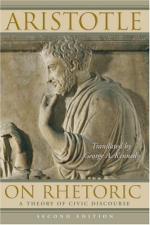
|
| Name: _________________________ | Period: ___________________ |
This test consists of 15 multiple choice questions and 5 short answer questions.
Multiple Choice Questions
1. What did Aristotle think was the intent of all voluntary actions?
(a) Some apparent good or pleasure.
(b) Some apparent good, recognition, or pleasure.
(c) Some apparent good or recognition.
(d) Some apparent recognition or pleasure.
2. How did Aristotle define that which is unpleasant?
(a) The opposite to any of the things that have been determined to be pleasant.
(b) The opposite to certain things that have been determined to be pleasant.
(c) The opposite of good.
(d) The opposite of pleasure.
3. Which one of the following was an example of national defense provided in Book I, Chapter 4?
(a) Risks.
(b) Fortifications.
(c) Strategy.
(d) Previous battles.
4. According to Aristotle's explanation, how would a speaker approach a subject when using the logical appeal?
(a) Indirectly.
(b) Carefully.
(c) Directly.
(d) Boldly.
5. How many causes of human action did Aristotle detail in Book I, Chapter 10?
(a) Eight.
(b) Five.
(c) Seven.
(d) Ten.
6. According to Aristotle, what act should the political rhetorician be concerned with?
(a) The act of legislation.
(b) The act of limitation.
(c) The act of ratification.
(d) The act of rejection.
7. How did Aristotle think the speaker should present themselves to the audience?
(a) In a way that appeared to be above the audience.
(b) In a way that inspired knowledge.
(c) In a way that appeared to be on the same level as the audience.
(d) In a way that inspired trust.
8. As explained in Book I, Chapter 3, which type of rhetoric attempted to convince a legislature to take a particular action?
(a) Political.
(b) Non-political.
(c) Tactical.
(d) National.
9. Why did Aristotle think the universal law was higher than the special law?
(a) It always changes.
(b) It never changes.
(c) It changes for the better.
(d) It rarely changes.
10. What did Aristotle say could not be considered good?
(a) Something that is instrumental to something else.
(b) Something that is supplemental to something else.
(c) Something that is relied upon by something else.
(d) Something that is dependent on something else.
11. How did Aristotle explain the binding extent of contracts?
(a) They were not binding.
(b) Only between two individuals.
(c) Only between the courts and an individual.
(d) Only between two individuals or the courts and an individual.
12. Which one of the following was not included by Aristotle as a cause for the feeling of calmness?
(a) When someone has been wronged in an unintentional way.
(b) When someone has helped a person.
(c) When someone is not known well by a person.
(d) When someone does not associate with anyone.
13. Which kind of distinction was made by Aristotle between war and peace, and national defense?
(a) No difference.
(b) Complicated.
(c) Subtle.
(d) Distinct.
14. As explained by Aristotle in Book I, Chapter 10, what was the concern of the legal rhetorician?
(a) Only proving wrongdoing.
(b) Neither proving nor disproving wrongdoing.
(c) Only disproving wrongdoing.
(d) Either proving or disproving wrongdoing.
15. How did Aristotle describe the feeling of friendship?
(a) One-sided.
(b) Expendable.
(c) Essential.
(d) Reciprocal.
Short Answer Questions
1. Of the two kinds of witnesses, why did Aristotle think the ancient witnesses were useful?
2. Who did Aristotle think calmness was felt towards?
3. How many forms did Aristotle think the emotional appeal could take?
4. What description of the ethical appeal was given by Aristotle?
5. According to Aristotle, what was the most basic cause of pleasure?
|
This section contains 632 words (approx. 3 pages at 300 words per page) |

|




